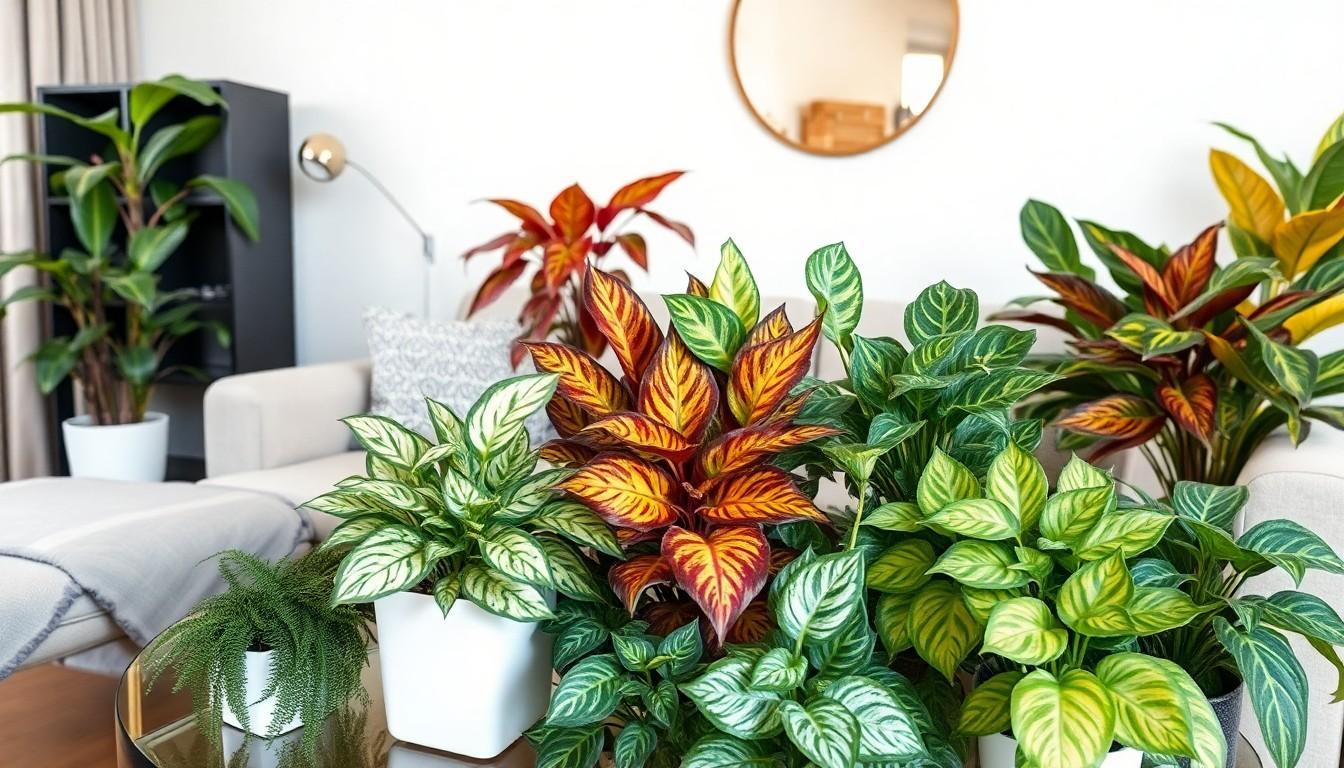Imagine a world where your houseplants not only purify the air but also steal the spotlight with their stunning colors. Variegated houseplants are the rock stars of the botanical world, flaunting their unique patterns and vibrant hues. They’re like a breath of fresh air in a sea of green, turning even the dullest corners of your home into a lively oasis.
What Are Variegated House Plants?
Variegated house plants showcase leaves with different colors and patterns, adding unique visual interest to indoor environments. These plants display a mix of greens, whites, yellows, or even pinks, resulting from a genetic mutation that affects chlorophyll production. A houseplant with variegation typically thrives in similar conditions as its non-variegated counterparts, requiring appropriate light, watering, and humidity.
Specific examples of variegated plants include the variegated monstera, philodendron, and pothos. Each species brings distinctive leaf patterns that can range from spotted to marbled designs. Variegated forms often attract collectors and plant enthusiasts due to their rarity and beauty.
Maintaining variegated house plants may require extra care. The variegated sections of the leaves often have lower chlorophyll levels, leading to a higher need for sunlight compared to fully green plants. The right balance of light supports healthy growth, preventing the loss of vibrant colors.
These plants can also influence air quality significantly. Research indicates that houseplants purify indoor air pollutants, promoting a healthier living space. With their decorative appearance and environmental benefits, variegated house plants serve a dual purpose in homes.
He or she cultivates a vibrant indoor garden with variegated house plants. These plants enhance aesthetics while contributing to a healthier atmosphere. Their unique characteristics make them a popular choice among plant lovers, combining beauty and function seamlessly.
Benefits Of Variegated House Plants

Variegated house plants offer unique advantages that enhance indoor environments. They contribute both visually and environmentally to home settings.
Aesthetic Appeal
Striking colors and unique patterns define variegated house plants. These features captivate attention and elevate the décor of any space. Collectors often seek rare types, such as variegated monstera and pothos. The visual interest they bring transforms an ordinary room into a vibrant oasis. Their diverse leaf designs complement various interior styles, from modern to traditional. Adding variety to a plant collection is easy with the integration of these visually appealing species.
Air Purification
Variegated house plants excel at improving indoor air quality. Their ability to filter out harmful pollutants makes them a practical choice for any home. Several studies indicate that house plants effectively reduce toxins like formaldehyde and benzene. By incorporating these plants, individuals can create a healthier living environment. Their unique leaf structures increase surface area, enhancing their air-purifying capabilities. People often appreciate the dual benefits of beauty and functionality that variegated plants provide.
Popular Variegated House Plants
Variegated house plants offer a stunning aesthetic to indoor spaces while providing air purification benefits. Several varieties enjoy popularity among collectors and plant enthusiasts.
Variegated Pothos
Variegated pothos features eye-catching leaves with a mix of green and golden hues. This plant thrives in various conditions, tolerating low light while appreciating bright, indirect sunlight. Variegated pothos grows rapidly, making it a fantastic choice for those seeking quick greenery. Regular watering keeps the soil slightly moist, fostering healthy growth. The vibrant foliage not only decorates a room but also enhances air quality, filtering toxins like formaldehyde.
Variegated Snake Plant
Variegated snake plant stands out due to its striking leaves adorned with creamy white edges. This hardy plant thrives in different lighting conditions, from low light to bright indirect light. Watering infrequently suits this plant, as it prefers to dry out between sessions. The upright growth habit allows for creative placement in various areas. Beyond its visual appeal, the variegated snake plant excels at purifying indoor air, removing pollutants like xylene and toluene.
Variegated ZZ Plant
Variegated ZZ plant showcases glossy leaves with beautiful cream and green patterns. This robust species tolerates low light, making it suitable for dimly lit areas. Minimal watering ensures it flourishes since it prefers drier environments. With a slow-growing nature, patience rewards owners with stunning greenery over time. Additionally, the variegated ZZ plant contributes to improved air quality, eliminating toxins such as benzene and toluene from indoor spaces.
Care Tips For Variegated House Plants
Caring for variegated house plants ensures their health and beauty. Each type may have specific needs, but general guidelines apply to most.
Lighting Requirements
Bright, indirect light benefits variegated house plants. Optimal conditions promote vibrant colors and healthy growth. Direct sunlight may scorch their delicate leaves. Adjusting exposure based on the plant type helps maintain its unique patterns. For example, the variegated pothos thrives in moderate to bright light, while the variegated ZZ plant tolerates low light. Ensuring plants receive appropriate light aids in maximizing their striking visual appeal.
Watering Guidelines
Regular watering maintains the vigor of variegated house plants. Soil should dry slightly between watering sessions to avoid overwatering. Signs of underwatering include droopy leaves, while yellowing indicates excess moisture. Monitoring the plant’s specific needs aligns with its growth stage. For instance, variegated snake plants prefer less frequent watering during winter months. Adapting the watering schedule enhances overall plant health and appearance.
Soil and Fertilization
Choosing well-draining soil supports variegated house plants’ growth. A potting mix with organic matter encourages healthy root development. Fertilization schedules vary; typically, every 4-6 weeks during the growing season suffices. Using balanced, water-soluble fertilizers provides necessary nutrients. Variegated monstera, for example, benefits from higher nitrogen content for robust growth. Customizing soil and fertilizer choices enhances plant vitality and color vibrancy.
Conclusion
Variegated houseplants offer a unique blend of beauty and functionality that enriches any indoor space. Their striking colors and patterns not only captivate the eye but also contribute to a healthier environment by purifying the air. With proper care and attention to their specific needs, these plants can thrive and bring life to homes. Collectors and enthusiasts alike appreciate the rarity and charm of varieties like the variegated monstera and pothos. Incorporating variegated houseplants into home décor is a rewarding choice that enhances both aesthetics and air quality, making them a valuable addition to any plant lover’s collection.

